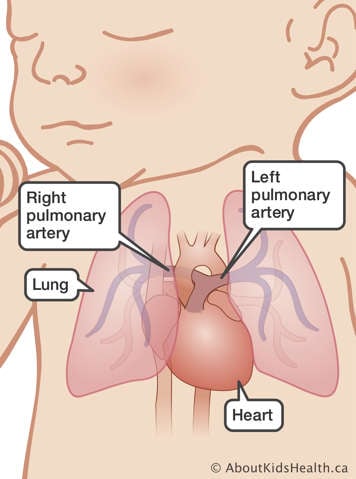What is pulmonary hypertension?

The pulmonary artery carries blood from the right side of the heart to the lungs. Pulmonary hypertension occurs when there is high pressure in this artery. High pressure in the pulmonary artery can slow the flow of blood reaching the lungs to be oxygenated.
Symptoms of pulmonary hypertension
Pulmonary hypertension is very rare in children, but it is serious. Because it is so rare, it can go undiagnosed for a long time.
The symptoms of pulmonary hypertension overlap with symptoms of other heart and lung problems and can vary depending on the age of the child and the severity of the condition. In babies, fast breathing, poor weight gain and cyanosis (blue lips or blue skin) are the most common features. In older children, symptoms may include decreased exercise tolerance, fatigue, shortness of breath, cyanosis, chest pain and fainting or near fainting.
Causes of pulmonary hypertension
There are several known causes of pulmonary hypertension. Depending on the underlying cause, pulmonary hypertension may be short-term and improve over time, or persistent and progressive.
One of the most common types occurs in the first 24 hours of life in some newborns. The pressure in the pulmonary arteries is higher when a baby is born, but it usually lowers over the next few hours or days. When the pressure stays high, it is called persistent pulmonary hypertension of the newborn. This can occur in newborns who are born with severe infections, pneumonia, meconium aspiration or lung disease. It is usually treated successfully in a neonatal intensive care unit.
Conditions that may result in or be associated with pulmonary hypertension include:
- congenital heart disease
- chronic lung disease
- structural abnormalities of the lungs or lung vessels
- blood clots in the lung vessels
- sleep disorders
- chronic exposure to high altitude
- drug and toxin induced
- sickle cell disease
- some rheumatologic conditions, such as lupus
- some genetic syndromes, such as Down syndrome
While rare in children, pulmonary hypertension may also appear on its own and it is not clear what causes it. This kind of pulmonary hypertension is usually called idiopathic. There are also inherited forms of pulmonary hypertension.
Eisenmenger syndrome is pulmonary hypertension resulting from congenital heart disease, such as a ventricular septal defect (VSD). Extra blood flows to the lungs through the VSD. Over time this causes high pressure in the lungs, and if the VSD is not closed the pressures can become high enough that the blood flow through the heart reverses. The high pressure causes the blood flow through the VSD in the heart to reverse and go from the pulmonary arteries to the body. Because this blood has not yet travelled to the lungs, it is "blue blood" and may cause cyanosis. Eisenmenger syndrome can develop in early childhood or take time to develop over years.
Diagnosis of pulmonary hypertension
The following investigations are used to diagnose pulmonary hypertension:
- electrocardiogram (ECG)
- chest X-ray
- echocardiogram
- bloodwork
Heart catheterization is the best test to confirm the diagnosis, assess severity and obtain more accurate measurements. It also lets the health-care team identify which specific treatments will be most effective.
Some children may also benefit from other tests, including cardiac MRI, chest CT, a sleep study and genetic testing.
Treatment of pulmonary hypertension
Treatment of pulmonary hypertension is aimed at relieving symptoms. It includes:
- oxygen to lower lung pressure to help the child breathe more easily
- drugs called diuretics to get rid of extra fluid in the body
- specific drugs given by mouth such as sildenafil or tadalafil, bosentan, macitentan or ambrisentan, or prostacyclin type medication (epoprostenol, trepostinil, selixipag). These medications may lower the pressures in the pulmonary artery.
Pulmonary hypertension is a challenging condition to treat, and treatment is individualized for each child based on the cause of pulmonary hypertension and severity of symptoms. The goals of treatment include slowing progression of the disease, preventing lung damage, and optimizing health through immunization and nutrition. Children with severe or progressive pulmonary hypertension benefit from assessment by cardiologists and multidisciplinary health-care teams with expertise in pulmonary hypertension.
In rare cases, children with pulmonary hypertension have needed a lung transplant.
Long-term problems caused by pulmonary hypertension
Pulmonary hypertension can lead to various problems:
- The right ventricle of the heart needs to work harder to pump blood to the lungs. This makes the right side of the heart get bigger. In the long term, it can lead to heart failure.
- When the arteries are under high pressure for a long time, tissue in the arteries becomes stiff. As the disease goes on and the high pressure continues, the blood vessels get scarred. This makes them weak and at risk of tearing.
- The condition can also lead to abnormal heart rhythms because the right ventricle is stretched.